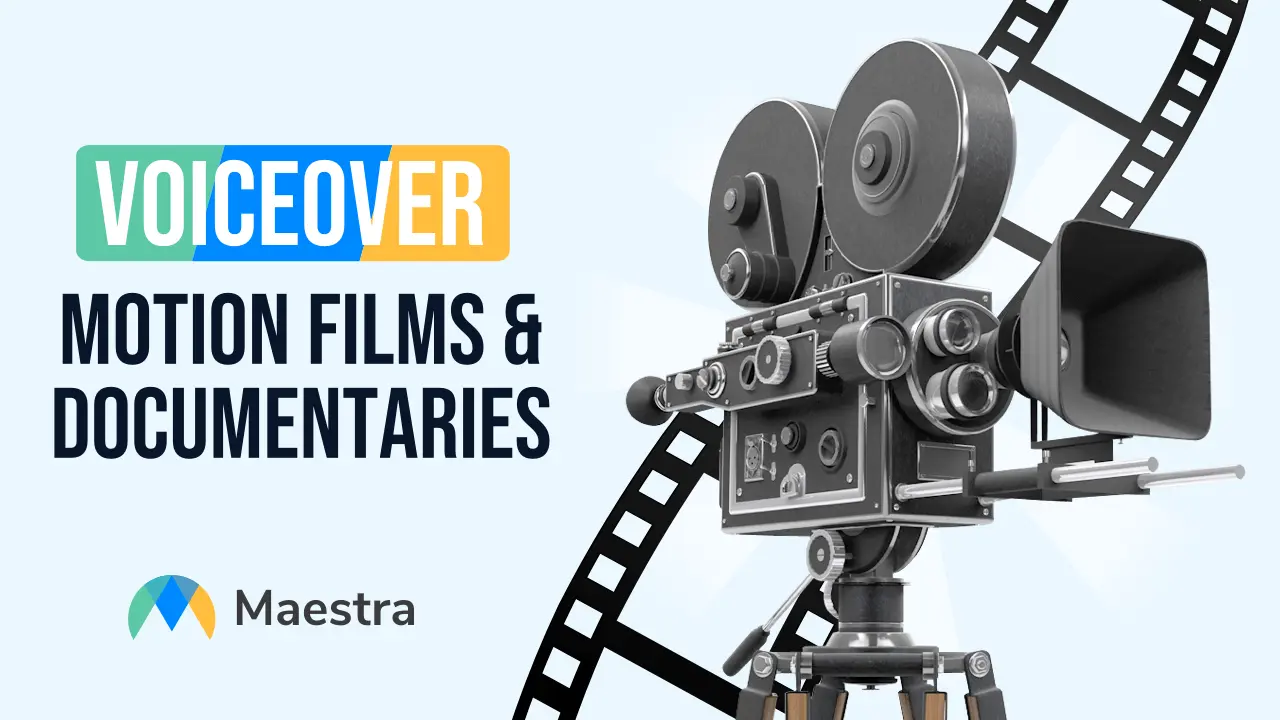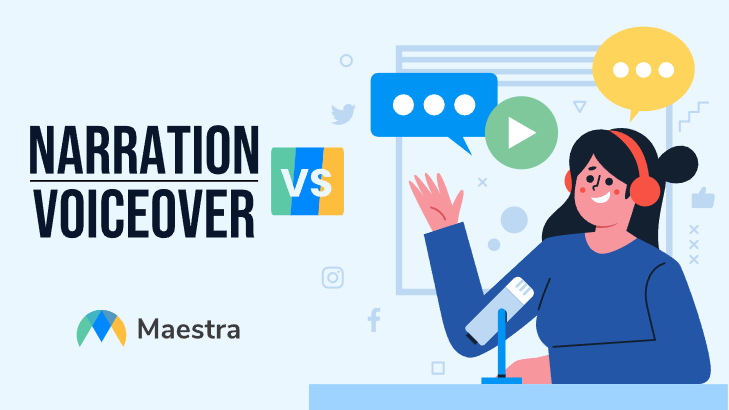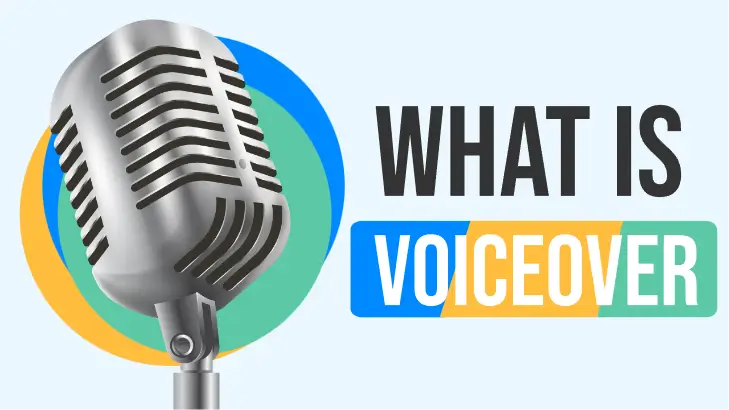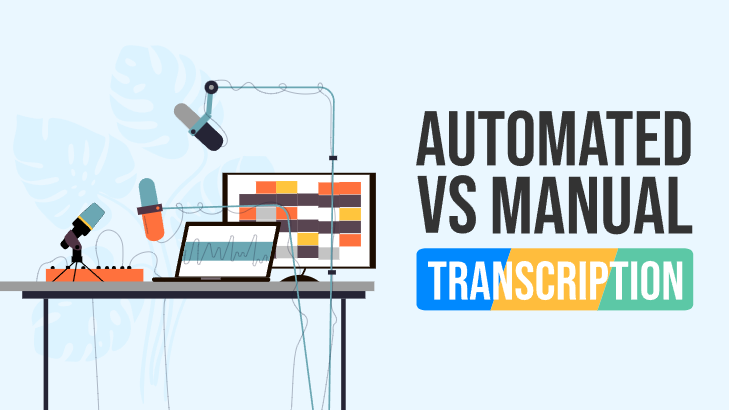Using Voiceover for Motion Films and Documentary Films

Introduction to Voiceovers
One of the most important things video content creators have to realize is that viewers will see and understand their videos in different ways. At times it may be difficult to convey the intended message or to say all that you had hoped to say given directorial, temporal, and visual limitations. One method which has been developed to combat some of these issues and to inspire greater communication and accessibility more generally is voiceover.
Voiceover is spoken audio which clarifies, elaborates upon, or narrates video content. It is overlaid on relevant footage and often read by a dedicated talent who does not appear in the video itself.
The most effective voiceover will be clean, clear, and easy to follow and understand. Its main aim is to complement and enhance the viewing experience. When applied intelligently, it can help boost viewership, increase engagement with content, and improve SERP.
Voiceover has a wide variety of applications, from tutorial videos to foreign film localization. In this article, we’ll go over a few of the most common and established uses for voiceover and demonstrate the benefits to be reaped by including it in your videos as well.
Future of Voiceovers in Films
Voiceover is coming into increasing use in a number of different sectors of the video-creating community.
Tutorial videos are rapidly becoming one of the quickest and easiest solutions for learning a skill--from simple things like cooking a pasta dish or caring for goldfish to more complex tasks like repairing a smartphone or filing tax forms. Voiceover is extremely useful in such situations because it provides verbal explanation alongside a visual walkthrough. Because the individual in the video will often be absorbed and focused on the task at hand, using voiceover to narrate the actions on screen is a much more clear and helpful means of teaching.
Advertising has also become a major application of voiceover. Ads are becoming more stylized and narrative-driven than in the past, and voiceover is now being used to enumerate the features and advantages of products while incentivizing but unrelated footage plays on screen. Take, for example, the ubiquitous medication ads where scenes of happy families, athletic activities, and social interactions are shown on screen while a voiceover details the benefits and risks of said drug.
The same principle applies with movie trailers. To advertise upcoming films, studios will put together rapid sequences showing clips of action, dialogue, or jokes which are featured in the film but which are out of order and seemingly unrelated. Voiceover is used to tie these bits together and supply an underlying narrative so potential viewers will understand what the film will be about and want to see it.
Examples like these are just the tip of the iceberg, however, and as time goes on, voiceover will become an increasingly large part of video production more generally.
How to Use Voiceovers for Motion Films
Voiceover is of great use in motion pictures as well. Its primary uses are in putting together special editions of critically acclaimed films and translation/localization for foreign release.
Films which do especially well at the box office, receive high praise from reviewers, or generate a large fan base or following are liable to be re-released as a special edition or director’s cut. These editions will usually include voiceover commentary by personnel who worked on it alongside portions of or the entirety of the film. Directors will talk about the creation of the script, the task of filming, deleted scenes, critique of their own work, and more. Actors may also appear and talk about their experience of creating a character, interacting with fellow talent, and various other anecdotes. Supporting personnel can even be brought in occasionally to elaborate on special effects, musical score, sets, and other technical aspects. All this is played around or over relevant scenes to help audiences learn more about and better understand the film itself.
Voiceover can also be used to translate a film’s dialogue into other languages so it can be released internationally. The disembodied and removed nature of voiceover tends to introduce a measure of dissonance into the smooth flow of a film, but can be useful when dealing with gestures, idioms, expressions, and references which don’t translate easily into other languages.
How to Use Voiceovers for Documentary Films
Perhaps the most important use of voiceover is in documentary films where it provides important narrative structure to otherwise opaque footage.
Nature documentaries are becoming increasingly popular as awareness about the planet and its threatened climate spreads. These films are usually constructed from various pieces of footage shot in beautiful, endangered, inaccessible, or otherwise important or interesting locations. The countries, the geological features, the animals, and the plantlife featured in these shots are not known to the average viewer, and their significance is lost without some form of narration. Voiceover serves to provide the necessary facts about each scene and also to piece them together to tell a story about our planet and its beauty and fragility.
Historical documentaries face many of the same challenges nature documentaries do. History is an incredibly complex process which is difficult to distil into a single encompassing narrative. Voiceover plays the part of tying together the myriad facts, photos, letters, and dates which the creators of a documentary desire to include. Voiceover condenses all these to form a story and a timeline which make sense to viewers but which still include the most vital facts and events. This helps the documentary to be both accurate and accessible.
Automated Human-like Text to Speech
Adding voiceover to videos can be extremely beneficial, but is also a lot of work. As a result, some creators may choose to automate the process by feeding their voiceover scripts into a vocal synthesizer.
Speech synthesizers have come a long way since their development in the 1960s, but are still far from being perfected. They will still occasionally get tripped up by names, homographs, and other unusual linguistic constructions, and this is something creators need to keep in mind, as it may affect flow and watchability.
This being said, many of these programs can replicate human speech quite well, even to the point that they can be mistaken for real people. Some low-quality software will still sound metallic or robitoc, however, so when choosing a vocalizer program, it’s important to remember that clarity, above all else, is what makes a good voiceover.
How Maestra Can Help
Now that you know about the benefits and growing popularity of voiceover, you’ll likely be searching for the best way to include it in your videos.
Maestra is the all-in-one software suite for video content creators of all kinds. Even such a complex process as creating and overlaying voiceover is made easy with Maestra’s automatic voiceover and dubbing tool. With this, you are free to upload your video and voiceover script to Maestra’s website in any file format you like. Select from over fifty languages and a variety of different vocal synthesizers, and Maestra will generate a complete customized voiceover in seconds or minutes, then automatically apply it to your video. Use the simple but versatile editor to put on the finishing touches, and you’re ready to download, export, or even share your file right from Maestra’s website. ____________________
Maestra is a powerful tool for creators, offering solutions for transcription, captioning, dubbing, and virtual collaboration. To see for yourself what Maestra’s industry-leading software suite can do, visit our website and sign up for a full-access free trial today.



